|
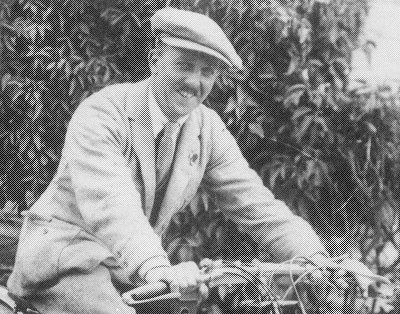
Howard Raymond Davies. |
The company was founded by
Howard Raymond Davies, who used his initials for the name 'H.R.D.'
He was a
former tester, and competition rider for Sunbeam, a former competition rider
for A.J.S., and a well known, and successful motorcycle racer.
His successes in the Isle of Man T.T. included a win in
the 1921 Senior, and second place in the 1921 Junior, both on
A.J.S. machines, and second place in 1914 Senior, on a Sunbeam. |
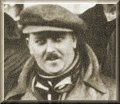
|
Read about Howard Davies
|
|
|
|
| Howard began to think about producing his own
motorcycles, around the time he was demobilised, after the
First World War. In the early 1920s he gained a lot of
riding experience at A.J.S., and became well known after his
success in the 1921 T.T. The 1922 and 1923 T.T.'s
were a disappointment because of the unreliability of the A.J.S.
engines. On both occasions Howard only managed a few laps, after
which his machine broke down. He had a similar experience in the
1924 T.T. when riding an O.E.C., and so must have decided that the
only way to regain success was to produce a reliable machine
himself. Howard joined forces with E. J. Massey to form H.R.D. |
| Massey was
an artist and ex-motorcycle manufacturer, whose first venture in
the industry had been to design the Massey-Aran machines that
were built in Birmingham. Massey later joined forces with the F. J. Cooper Sidecar Company of
Belgrave Road, Birmingham, to produce the Massey motorcycle.
By May 1924 Massey had already produced a set
of drawings for a proposed machine. Howard showed them to
friends in the trade, and asked for their opinion of the
design. Their opinions were favourable, and so he decided to
form the new company. |

The original location of H.R.D. at
Heath Town. |
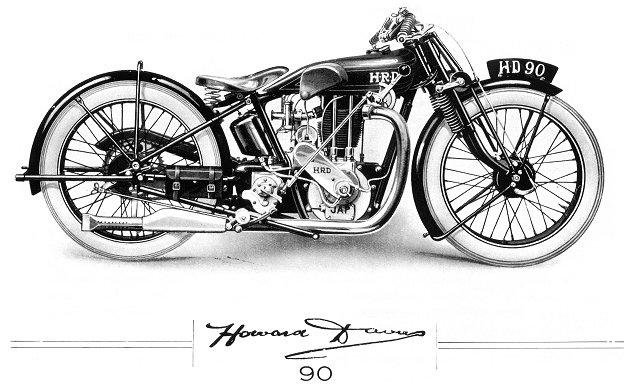
One of Massey's illustrations from the first H.R.D.
catalogue.
| The new company, H.R.D. Motors Limited, was
registered in September 1924, with a nominal capital of £3,000.
Howard Davies was Managing Director. Premises were acquired in Heath
Street, Heath Town, but the old building was in a poor state,
particularly the ground floor. It had previously been
occupied by a locksmith, and before that by Tomes & Beard
who made the 'Original Universal' bicycle. The plan was to build a comparatively small number of high
class motorcycles, at competitive prices, that were designed to appeal to
the connoisseur. The best materials would be used, along with the highest
standards of workmanship. As the company was in no position to manufacture any
of the major components, the best available would be brought-in. |
 |
The first task was to ensure that the company
had some machines to go on display at the forthcoming Olympia show.
It was essential for H.R.D. to have a presence there, in
order to gain much-needed publicity, and for the machines to
be seen by the trade and public alike.
The exhibition opened on 3rd November, and so the
difficult task of meeting the deadline began in earnest. The
first machine had been designed on paper in May, but a lot of work
was required to make it a reality. Obtaining the various components
from manufacturers, and getting other parts made in time was a
nightmare. Howard quickly assembled a small experienced team to
build the machines, including his old friend Albert
Clark, whose grandfather was Henry Clarke of Cogent Cycles.
Four models were produced for the show, top of the range
being the HD90, which included a special JAP 500c.c. racing
engine, and had a guaranteed top speed of 90m.p.h. The
machine sold for 90 guineas. Next was the HD80, powered by a
special 350c.c., overhead valve, double port, JAP engine. It
had a top speed of 80m.p.h., and sold for 80 guineas. |
| Another model, the HD70 included a
special 350c.c., overhead valve, JAP engine. It had a top speed of
70m.p.h. and sold for 70 guineas.
Last but not least was the HD70/S,
which was available as a solo, or sidecar machine.
It had a
500c.c., sports, side valve JAP engine, fitted with an aluminium
piston and racing cams. The solo version sold for 66 guineas and the
combination sold for 83 guineas.
The machines were the first
motorcycles to be fitted with a saddle petrol tank, and included a
lot of new features such as a compact loop frame, low riding
position and good accessibility of the controls. |

From the 1925 catalogue. |
|
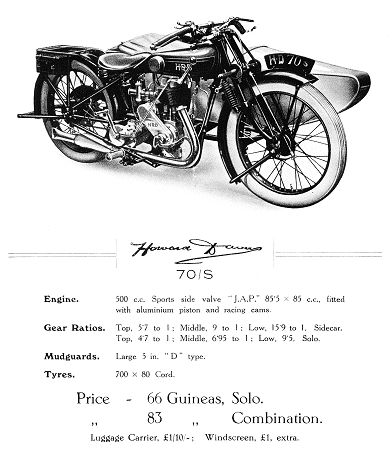
From the 1925 catalogue. |
The machines had good ground clearance, straight torque
rods, massive steering head, underslung handlebars and 'D' section
mudguards. The rear mudguard was hinged to allow the rear wheel to be
removed.
The major components included JAP engines, Burman close
ratio gear boxes, Druid or Webb forks incorporating shock dampers, enclosed
Renold or Coventry chains, Binks two lever carburettors, M.L. magnetos,
exceptionally large internal expanding brakes, and 'Pilgrim' mechanical
lubrication pumps.
The four machines were completed just in time for the
show. The major problem had been getting outside
manufacturers to produce the parts on time. |
| The machines
were finished in black and lined in gold. The new models showed a
very promising start, receiving a lot of interest and good
publicity. After the show it took some time for the first production
models to appear. Machinery had to be purchased, and the workshop
organised.
Billy Price was head-hunted from A.J.S. to oversee
production. The problem of obtaining parts on time was still there,
particularly with the special sports JAP engines. J. A. Prestwich
only made these in limited numbers.
E. J. Massey's practical
abilities were very limited and this led to several problems when
setting up the machinery. In January he left for pastures new. |
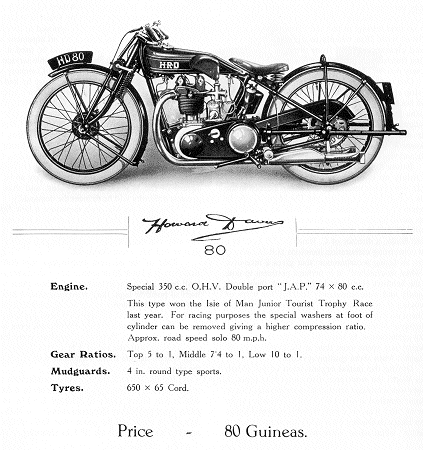
From the 1925 catalogue. |
| 1925 was destined to be a good year for the company.
Many of the early machines were sold for competition use,
and were very successful. Excellent road test reports
appeared in the press, and by May about 60 machines had been
built. |
|
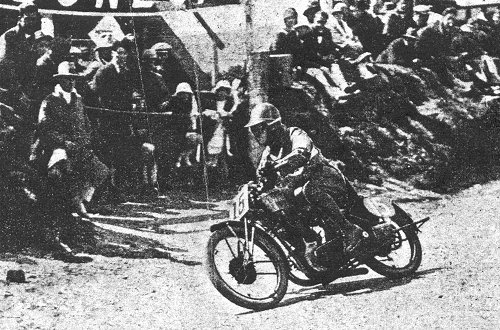
Howard Davies cornering at Craig-ny-baa
in the 1925 Isle of Man T.T. |
H.R.D. now got
ready for the forthcoming Isle on Man T.T., with Howard Davies in
the senior and Harry Harris in both the Junior and the Senior. Five
motorbikes were prepared for the T.T., three 350c.c. machines and
two 500c.c. machines.
They were standard production models with minor
differences. They had larger capacity petrol tanks, extra
engine supports and larger ribbed brake drums. |
| On arrival at the
island, Howard took over J. W. Shaw's Junior entry and so would race
in both the Junior and Senior. Practising started on 1st June and
the machines performed extremely well. This was to be a very
successful outing for the company, as Howard came second in the
Junior race, just behind W. L. Handley on his Rex Acme. Harry Harris
came in fifth. The Senior was a repeat of Howard's 1921 success. He won the race in 3hours 25minutes 35secs,
just ahead of F. A. Longman on his A.J.S. Howard's average speed was
66.13m.p.h. Unfortunately Harry Harris was forced to retire from the
race because of a broken chain. He was lying in 7th place at the time. On
their return to Wolverhampton, a big celebration followed in the Half Way
House on the Tettenhall Road. A Union Jack was raised in front of a large
enthusiastic crowd, and the
trophy was displayed. |
| Howard Davies and guests at the
T.T. celebration at the Half Way House.
From the July 1925 edition of Butler's
magazine. |
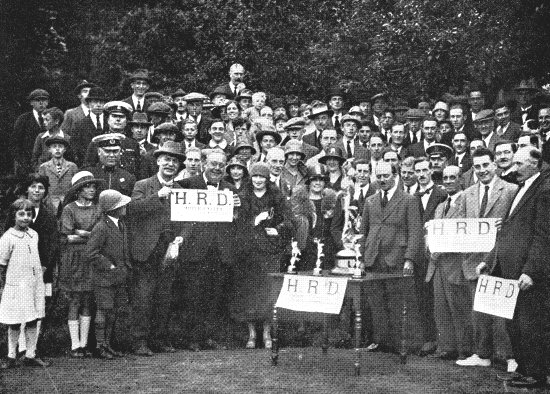 |
|
From Butler’s
magazine, July 1925:
The New Inn,
Finchfield Road/Castlecroft Road, Finchfield
Presentation
to the Winner of the Senior T.T. Race
On Saturday evening, July 4th,
a convivial evening was arranged to present Mr.
Howard Davies, Winner of the Trophy, with a small
souvenir. Mr. Bradford occupied the chair and
introduced Mr. Alderman Jeffs, who had kindly come
to make the presentation. Alderman Jeffs, in asking
Mr. Davies' acceptance of a pipe and pouch from a
few friends, said his performance was a wonderful
achievement in a splendid race and great credit was
due to him. Mr. Davies responding said he heartily
appreciated the gift not only for its intrinsic
value, but because it came from friends. He
appreciated the very kind things Mr. Bradford and
Alderman Jeff s had said about him, but declared
that his success was largely due to the splendid
loyalty and co-operation of his staff, especially
Messrs. Harris and Lawrence, and concluded by
wishing Mr. Harris success next time as he
thoroughly deserved a win.
Messrs. Tonks and Bennett were
responsible for the pianoforte solos which were well
rendered and appreciated.
A vote of thanks was passed to
Mr. Bradford for presiding, to Mr. Alderman Jeffs
for kindly making the presentation, and to Mr.
Roberts for the arrangements of a very enjoyable
evening.
During the evening the
following lines, written by himself, were read by
Mr. J. B. Beckett:
|
To Mr. Howard R.
Davies
Gentlemen, we have
with us a man of great fame,
May he live long
with the rest who have made their name,
He won that great race with a thousand
thrills,
Down the deep vales and over the hills,
The course he went over without a
mishap,
Keeping good time on every lap
And on to the finish, and over the line
These words were uttered "You've beat
record time."
Then to old England he made his way,
What a welcome he had on that glorious
day,
People who knew him shook him by the
hand,
"Good luck to you Howard, you won the
race grand,"
And now that we have him amongst us
to-night,
May his life in future be full of
delight,
And now to conclude these few words I
say
Good luck to you and your business from
day to day.
|
|
|
|